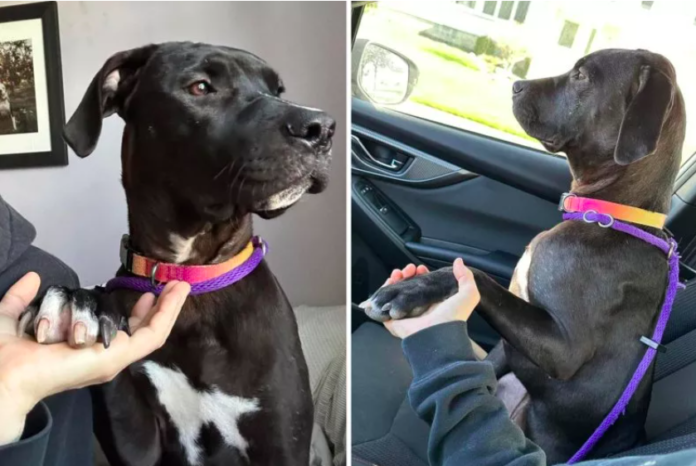Last Updated on April 20, 2024 by Fumipets
Foster Dog’s Heartwarming Paw-Holding Habit Steals Hearts
Discovering Dolly’s Unique Trait
In a heartwarming tale of resilience and affection, a once anxious and uncertain foster pup named Dolly has captured the hearts of shelter volunteers and social media followers alike with her endearing habit of seeking constant paw-holding. Dolly’s journey began when she was brought to the City of Buffalo Animal Shelter on January 14 as a stray puppy. Filthy, overweight, and visibly anxious, she struggled to adjust to shelter life. However, with time and care, Dolly blossomed into a loving and affectionate companion, eagerly awaiting her forever home.
Settling into Foster Care
On Valentine’s Day, Dolly found herself moving in with shelter volunteer Katie, who opened her heart and home to the sweet pup. With Katie’s nurturing presence, Dolly’s confidence soared, although sometimes a bit too much, as she became more comfortable in her surroundings. Yet, amidst her newfound confidence, one endearing trait stood out above all—the constant need for her paw to be held.
The Paw-Holding Phenomenon
Describing Dolly’s endearing behavior, Katie shared that the paw-holding began as a simple plea for attention. Initially, Katie taught Dolly the command “paw” as a way for her to request pets. To their delight, Dolly quickly grasped the trick, understanding that offering her paw meant receiving affection in return. Soon, she would eagerly extend her paw, seeking connection and comfort from her human companion.
From Shelter to Car Rides: Dolly’s Quirks
Interestingly, Dolly’s affectionate gesture extended beyond the confines of their home. Katie recounted how Dolly, upon being buckled into the car, would immediately raise her paw, insisting on their special connection even during car rides. Despite garnering amused looks from onlookers, Katie happily obliged, driving around while holding Dolly’s paw—a testament to their unbreakable bond.
Challenges in Adoption
Despite Dolly’s irresistible charm and remarkable qualities, including being housebroken, car-friendly, and sociable with other dogs, she continues to await her forever family. The shelter remains puzzled by her prolonged stay, speculating that it may be attributed to the phenomenon known as black dog syndrome. This phenomenon, characterized by darker-colored dogs waiting longer in shelters for adoption, sheds light on the challenges faced by pets like Dolly in finding loving homes.
Addressing Black Dog Syndrome
Black dog syndrome, akin to its counterpart concerning black cats, poses significant hurdles for these animals in securing adoption. Reasons behind this phenomenon range from superstitious beliefs to perceptions influenced by pop culture and shelter environments. Despite their loving nature and commendable traits, black dogs and cats often face extended waits in shelters, highlighting the need for increased awareness and adoption efforts.
Promoting Pet Adoption and Welfare
As Dolly’s story unfolds, it serves as a poignant reminder of the millions of pets awaiting their chance at a forever home. According to the American Society for the Prevention of Cruelty to Animals (ASPCA), approximately 6.3 million pets enter U.S. shelters annually, with an average of 17,260 arrivals each day. Tragically, around 920,000 surrendered animals are euthanized yearly, underscoring the importance of adoption campaigns, spaying and neutering initiatives, and behavioral rehabilitation programs.
In Conclusion
Dolly’s journey from a timid stray to a paw-holding sweetheart exemplifies the transformative power of love and compassion. As she eagerly awaits her forever family, her story serves as a poignant reminder of the countless pets still searching for homes. Through awareness, advocacy, and empathy, we can make a difference in the lives of animals like Dolly, ensuring they find the love and security they deserve.
Frequently Asked Questions (FAQs)
What is black dog syndrome, and why does it affect adoption rates?
Black dog syndrome refers to the phenomenon where darker-colored dogs, like black dogs, tend to wait longer in shelters before finding homes. This can be due to superstitious beliefs, negative portrayals in pop culture, or challenges in standing out in shelter environments.
How can individuals help combat black dog syndrome and promote pet adoption?
Individuals can contribute by spreading awareness about black dog syndrome, supporting adoption events, volunteering at shelters, and considering adopting black pets themselves.
What are some common misconceptions about black dogs and cats?
Common misconceptions include associating black animals with bad luck, aggressiveness, or being less photogenic than lighter-colored pets.
Are there any specific traits or qualities that make black dogs and cats excellent pets?
Black dogs and cats often possess loving, loyal, and playful personalities, just like their lighter-colored counterparts. They make wonderful companions and deserve the same opportunities for adoption and love.
How can shelters and rescue organizations work together to reduce euthanasia rates?
Shelters can collaborate with rescue organizations, implement effective adoption strategies, offer spaying and neutering services, provide behavioral training, and engage in community outreach to promote responsible pet ownership.
References: Newsweek: Link to original article


















